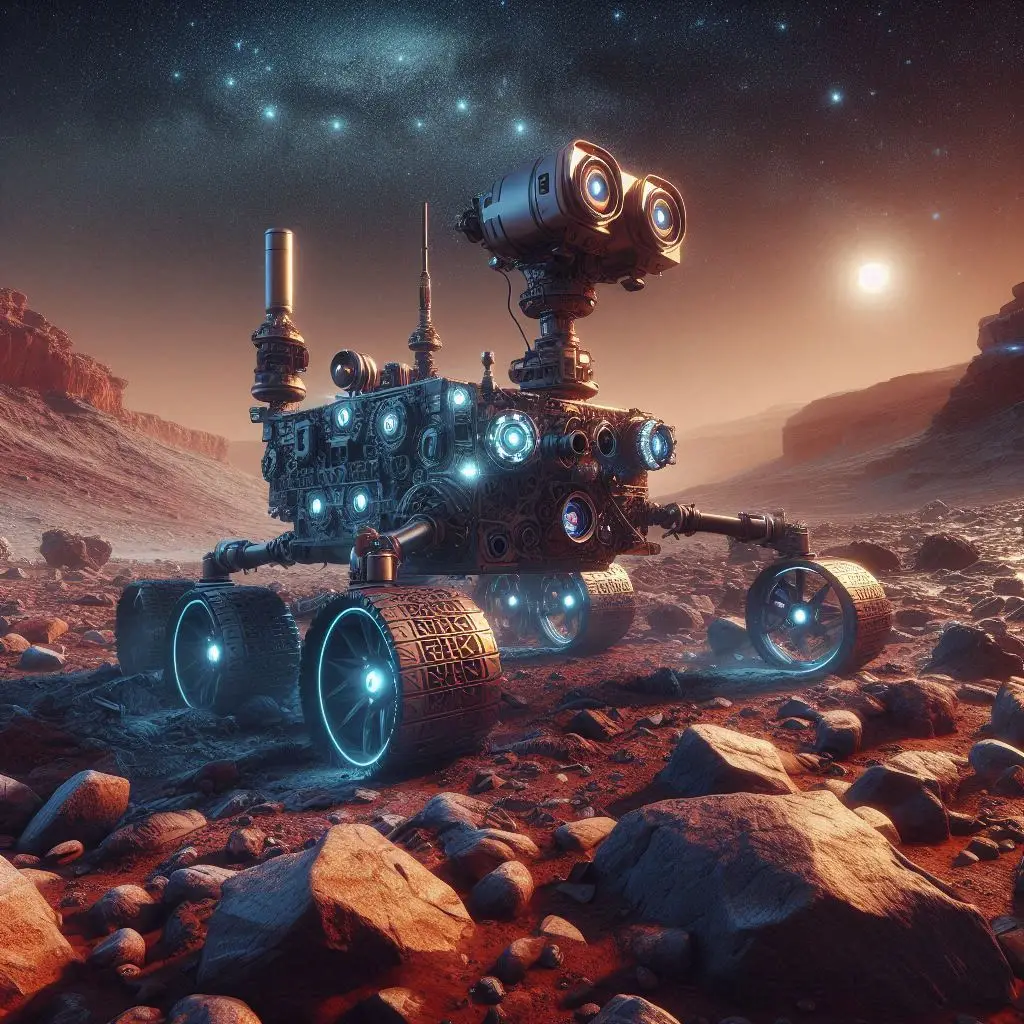NASA’s Mars Perseverance mission is one of the most ambitious and exciting endeavors in the history of planetary exploration. The mission aims to seek signs of ancient life, collect and cache samples for future return to Earth, and prepare for human exploration of the Red Planet. Since its landing in Jezero Crater on February 18, 2021, the rover has been making remarkable discoveries and achievements that are advancing our knowledge and understanding of Mars.
In this article, we will review some of the new findings by NASA’s Mars Perseverance mission that have been reported in the last few months. These findings include:
- The origin and composition of the rocks on the crater floor
- The evidence of multiple episodes of water activity and organic molecules
- The first sounds, images, and videos from the Martian surface
- The first flight of a helicopter on another planet
- The first collection and caching of Martian rock samples
The Origin and Composition of the Rocks on the Crater Floor
One of the main objectives of Perseverance is to study the geology and history of Jezero Crater, which was once home to a lake and a river delta billions of years ago. Scientists had expected to find sedimentary rocks on the crater floor, which would have formed from the deposition of sand and mud in a watery environment. However, to their surprise, they discovered that the crater floor was mostly covered by igneous rocks, which formed from the cooling and solidification of magma.
The rover’s instruments, such as PIXL (Planetary Instrument for X-ray Lithochemistry), SHERLOC (Scanning Habitable Environments with Raman & Luminescence for Organics & Chemicals), and SuperCam, revealed that the igneous rocks had different textures and compositions, indicating that they originated from different sources and processes. Some of the rocks were basaltic, meaning that they contained iron and magnesium minerals. Others were more felsic, meaning that they contained more silica and aluminum minerals.
One of the most intriguing rocks that Perseverance encountered was nicknamed “Rochette”, which was chosen as the first sample collection target. Rochette was a breccia, a rock composed of fragments of other rocks cemented together. The fragments were mostly olivine crystals, a green mineral that forms in magma. The cement was mostly pyroxene crystals, a black mineral that also forms in magma. The size and shape of the olivine crystals suggested that they grew slowly in a thick body of magma, such as a lava flow, a lava lake, or a magma chamber. The pyroxene crystals suggested that they formed later, when the magma cooled rapidly.
The discovery of Rochette and other igneous rocks on the crater floor has important implications for understanding the history and evolution of Jezero Crater and Mars. Igneous rocks are excellent timekeepers, as they record the precise moment when they crystallized from magma. By analyzing the isotopes (variations) of certain elements in the rocks, such as potassium and argon, scientists can determine their ages and compare them with other rocks on Mars. This can help answer questions such as: When did Jezero Crater form? When did the lake and river exist? When did Mars lose its magnetic field and most of its atmosphere? When did volcanism cease on Mars?
The Evidence of Multiple Episodes of Water Activity and Organic Molecules
Another major objective of Perseverance is to search for signs of ancient life on Mars, or biosignatures. Biosignatures are features or substances that indicate the presence or activity of living organisms, such as fossils, organic molecules, or isotopic ratios. Perseverance is equipped with several instruments that can detect and analyze potential biosignatures on Mars, such as MEDA (Mars Environmental Dynamics Analyzer), MOXIE (Mars Oxygen In-Situ Resource Utilization Experiment), RIMFAX (Radar Imager for Mars’ Subsurface Experiment), and Mastcam-Z.
One of the key requirements for life as we know it is water. Water is essential for many biological processes, such as metabolism, transport, and synthesis. Water also acts as a solvent for many chemical reactions and molecules that are involved in life. Therefore, finding evidence of past or present water on Mars is crucial for assessing its habitability and potential for life.
Perseverance has found abundant evidence that Jezero Crater was once a wet and dynamic place. The rover’s cameras have captured stunning images of ancient river channels, lake shorelines, delta deposits, and hydrated minerals on the crater floor. The rover’s laser has vaporized rocks and detected water molecules in their spectra. The rover’s drill has extracted cores from rocks and revealed their moist interiors.
The rover has also found evidence that water interacted with the rocks on multiple occasions, altering their original compositions and textures. For example, the rover’s instruments detected that some of the igneous rocks had been weathered by water, forming clay minerals and iron oxides. The rover also detected that some of the rocks had been fractured and filled with veins of minerals, such as carbonates and sulfates, that precipitated from water solutions.
The presence of water also increases the chances of finding organic molecules on Mars. Organic molecules are compounds that contain carbon and hydrogen, and sometimes other elements, such as oxygen, nitrogen, and sulfur. Organic molecules are the building blocks of life, as they form the basis of proteins, nucleic acids, lipids, and carbohydrates. Organic molecules can also be produced by non-biological processes, such as volcanism, meteorite impacts, or cosmic radiation.
Perseverance has detected several types of organic molecules on Mars, using its instruments such as SHERLOC and SuperCam. Some of the organic molecules were aromatic, meaning that they had ring-shaped structures of carbon atoms. Others were aliphatic, meaning that they had chain-like structures of carbon atoms. Some of the organic molecules were simple, such as methane or benzene. Others were more complex, such as kerogen or humic acid.
The origin and significance of the organic molecules on Mars are still unclear. They could have been formed by abiotic processes on Mars or delivered by meteorites or comets. They could have been preserved in the rocks for billions of years or degraded by harsh environmental conditions. They could have been associated with ancient life forms or unrelated to them. To answer these questions, more data and analysis are needed, especially from the samples that Perseverance will collect and cache for future return to Earth.
The First Sounds, Images, and Videos from the Martian Surface
One of the most remarkable achievements of Perseverance is to capture and transmit the first sounds, images, and videos from the Martian surface. These media not only provide scientific information but also create a sense of awe and wonder for the public and inspire future generations of explorers.
Perseverance is equipped with two microphones that can record sounds on Mars. One is attached to the SuperCam instrument, which can fire a laser at rocks and listen to the resulting shockwaves. The other is attached to the EDL (Entry, Descent, and Landing) camera system, which recorded the sounds of the rover’s landing on Mars. The microphones have captured sounds such as wind gusts, rover wheels crunching over rocks, laser zaps, drill whirs, and helicopter blades.
Perseverance is also equipped with 23 cameras that can take images and videos on Mars. Some of the cameras are used for navigation and engineering purposes, such as avoiding hazards or monitoring rover operations. Others are used for scientific purposes, such as studying rock textures or mineral compositions. The cameras have different resolutions, fields of view, filters, and zoom capabilities.
Some of the most impressive images and videos that Perseverance has taken include:
- The first 360-degree panorama of Jezero Crater
- The first selfie with Ingenuity helicopter
- The first color image of a Martian sunset
- The first close-up image of a Martian rock
- The first video of a sample collection
- The first video of a helicopter flight
The sounds, images, and videos from Perseverance have given us a new perspective on Mars and its environment. They have also revealed new details and mysteries that await further exploration.
The First Flight of a Helicopter on Another Planet
One of the most innovative and exciting aspects of Perseverance is that it carries a small helicopter named Ingenuity. Ingenuity is a technology demonstration that aims to test the feasibility and potential of powered flight on another planet. Flying on Mars is challenging because of its thin atmosphere, which is only about 1% of Earth’s at sea level. This means that there is less air to lift and propel a helicopter. To overcome this challenge, Ingenuity has a lightweight design (only 1.8 kilograms or 4 pounds), a large rotor span (1.2 meters or 4 feet), and a fast rotation speed (up to 2,800 revolutions per minute).
Ingenuity was deployed from Perseverance’s belly on April 3, 2021. It performed its first flight on April 19, 2021, becoming the first aircraft to fly on another planet. It rose about 3 meters (10 feet) above the ground, hovered for about 30 seconds, and then landed safely. It performed four more flights in April and May 2021, each one more ambitious than the previous one. It reached heights up to 10 meters (33 feet), distances up to 266 meters (873 feet), speeds up to 4 meters per second (9 miles per hour), and durations up to 117 seconds.
Ingenuity has exceeded its original goals and expectations. It has demonstrated that powered flight on Mars is possible and useful. It has also provided valuable data and insights for future aerial missions on Mars and other worlds.
The First Collection and Caching of Martian Rock Samples
One of the most important and challenging tasks of Perseverance is to collect and cache samples of Martian rocks and soil for future return to Earth. These samples will be analyzed by advanced laboratories on Earth, which will provide more detailed and accurate information than the rover’s instruments can. The samples will also be preserved for future generations of scientists, who may have new questions and methods to study them.
Perseverance has a sophisticated system for collecting and caching samples, which involves several steps and components. The system includes:
- A robotic arm with a coring drill that can bore into rocks and extract cylindrical cores about the size of a piece of chalk
- A bit carousel that can store and transfer the drill bits and sample tubes between the arm and the rover
- An adaptive caching assembly that can seal, store, and document the sample tubes inside the rover
- A sample handling arm that can move the sample tubes within the adaptive caching assembly
- A cache storage that can hold up to 43 sample tubes inside the rover
Perseverance performed its first sample collection attempt on August 6, 2021, targeting a rock nicknamed “Roubion”. The rover successfully drilled into the rock and retrieved a core, but when it checked the sample tube with its cameras, it found that it was empty. The rover tried again on August 27, 2021, targeting another rock nicknamed “Montdenier”. This time, the rover confirmed that it had collected a core and sealed it in a sample tube.
The rover performed its second sample collection attempt on September 1, 2021, targeting another rock nicknamed “Montagnac”. The rover successfully drilled into the rock and retrieved another core, which it also sealed in a sample tube.
The rover then stored the two sample tubes in its cache storage, marking the first collection and caching of Martian rock samples in history.
The two samples are expected to be part of a larger collection that will be returned to Earth by a future mission, which will involve another rover, an ascent vehicle, an orbiter, and a lander. The mission is planned to launch in the late 2020s and arrive at Mars in the early 2030s.
The samples collected by Perseverance will be invaluable for advancing our scientific understanding of Mars and its potential for life. They will also be priceless treasures for humanity’s exploration of the solar system.
Conclusion
Perseverance is an extraordinary mission that has achieved many milestones and discoveries on Mars. The rover has explored the geology and history of Jezero Crater, searched for signs of ancient life, captured sounds, images, and videos from the Martian surface, flown a helicopter on another planet, and collected and cached rock samples for future return to Earth.
Perseverance is not done yet. The rover still has many more objectives and challenges ahead. It will continue to study Jezero Crater and its surroundings, collect more samples from different locations, communicate with Ingenuity and other spacecraft orbiting Mars, test new technologies and experiments, and share its findings with the world.
Perseverance is not alone either. The rover is part of a global and collaborative effort to explore Mars and beyond. It is joined by other missions from different countries and organizations, such as China’s Tianwen-1, UAE’s Hope, ESA’s ExoMars, and more.
Perseverance is a testament to the power of science, technology, and human curiosity. It is a symbol of our quest for knowledge and adventure. It is a reminder of our potential and responsibility as a species.
Perseverance is a rover, but it is also a spirit.









Add a Comment: